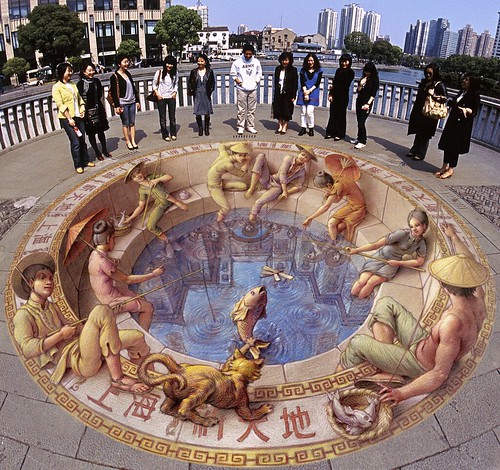Street painting has been recorded throughout Europe since the 16th century. Street painters in Italy are called madonnari (pronounced: mah-doan-are-ee with madonnaro being the singular form) because they often created pictures representing the Madonna.
Historically, madonnari were itinerant artists who lived a life of travel and freedom. Aware of the festival and holy days (holidays) in each province and town, they traveled to join in the festivities. They created images in public squares and in front of the local church using bits of broken roof tiles, charcoal, and some white chalk. Passersby would often leave a bit of bread or olive oil for the artist along with an occasional coin. The artists were often commissioned to create votos and ex-votos, and after the festivities or with the first rain, both the painting and the painter would vanish.
For centuries madonnari were folk artists, reproducing simple images with crude materials. World War II disrupted their itinerant tradition and reduced their numbers. In 1972 the first International Street Painting Competition was held in Grazie di Curtatone, Italy. The purpose of the competition was to record and publicize the work of those considered to be the last practitioners of this traditional art form. The oldest of the painters were already in their 90s. Over the years, the competition has drawn younger painters and larger crowds. The festival remains popular and street painting festivals around the world are modeled on the event. The 1972 festival resulted in national recognition of the validity of the art form by the Superintendent of Culture. This recognition caused a whole new generation of street painters to emerge. Within a decade these artists were using high quality commercial and handmade pastels to create copies of well known masterpieces.
In 1982 Kurt Wenner an American artist, began street painting in Rome, Italy and by 1983 he had developed a new art form known as anamorphic or 3-dimensional street painting. In 1984 his unique invention was documented by National Geographic in their award winning film "Masterpieces In Chalk". In this same year he won the title of Master Street Painter at the Grazie festival and in 1985 he created the first 3-dimensional street painting in the US at the Santa Barbara Museum of Art.
In 1987, Master Street Painters Kurt Wenner and Manfred Stader introduced the art of street painting to the Old Mission Santa Barbara, California. This was the first of numerous events throughout the United States that are modeled on the Italian festival at Grazie di Curtatone. Since this early introduction both traditional and 3-dimensional street painting have spread throughout the world. The innovative appeal of 3-dimensional street art has inspired many artists such as Julian Beever and Gary Palmer.














No hay comentarios:
Publicar un comentario